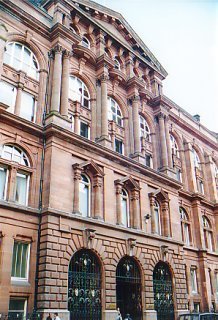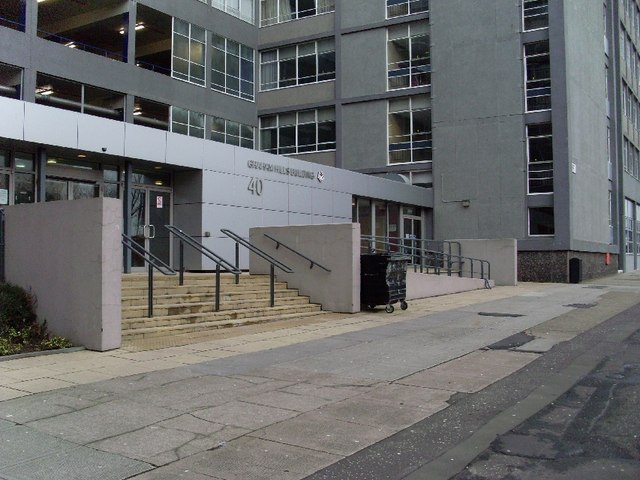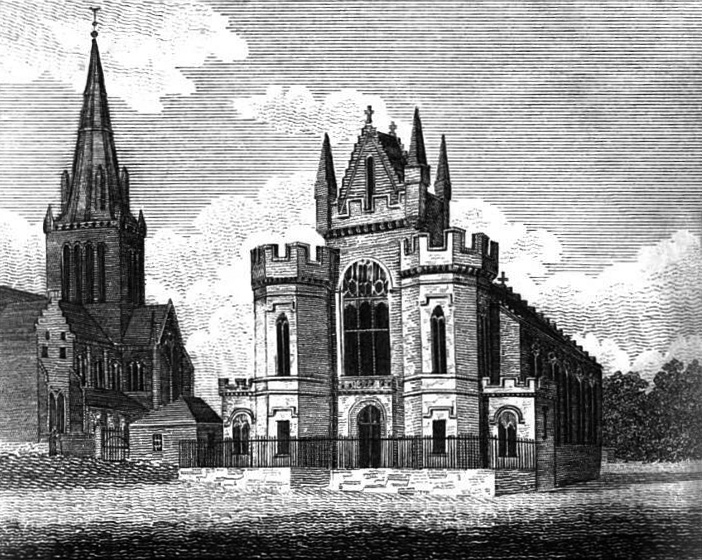|
John Anderson Campus
The John Anderson Campus, the main campus of The University of Strathclyde, is located in Glasgow, Scotland. The campus is self-contained in its own area which straddles the Townhead and Merchant City districts on the north eastern side of the city centre, while being only minutes from the M8 Motorway, George Square and is located midway between Queen Street Railway Station and High Street station on the North Clyde Line. History Early History (pre-1960) The John Anderson Campus was originally the only site of Strathclyde University, as the Jordanhill Campus did not become a part of the University until it incorporated Jordanhill College of Education in 1993. The campus is named after John H. D. Anderson (1726–1796), a former Professor of Natural Philosophy at the University of Glasgow, who left instructions in his will describing "a place of useful learning for the good of mankind and the improvement of science"- a second University for Glasgow that would teach practic ... [...More Info...] [...Related Items...] OR: [Wikipedia] [Google] [Baidu] |
Strathclyde University
The University of Strathclyde ( gd, Oilthigh Shrath Chluaidh) is a public research university located in Glasgow, Scotland. Founded in 1796 as the Andersonian Institute, it is Glasgow's second-oldest university, having received its royal charter in 1964 as the first technological university in the United Kingdom. Taking its name from the historic Kingdom of Strathclyde, it is Scotland's third-largest university by number of students, with students and staff from over 100 countries. The institution was named University of the Year 2012 by Times Higher Education and again in 2019, becoming the first university to receive this award twice. The annual income of the institution for 2019–20 was £334.8 million of which £81.2 million was from research grants and contracts, with an expenditure of £298.8 million.. History The university was founded in 1796 through the will of John Anderson, professor of Natural Philosophy at the University of Glasgow, who left ... [...More Info...] [...Related Items...] OR: [Wikipedia] [Google] [Baidu] |
University Of Strathclyde
The University of Strathclyde ( gd, Oilthigh Shrath Chluaidh) is a public research university located in Glasgow, Scotland. Founded in 1796 as the Andersonian Institute, it is Glasgow's second-oldest university, having received its royal charter in 1964 as the first technological university in the United Kingdom. Taking its name from the historic Kingdom of Strathclyde, it is Scotland's third-largest university by number of students, with students and staff from over 100 countries. The institution was named University of the Year 2012 by Times Higher Education and again in 2019, becoming the first university to receive this award twice. The annual income of the institution for 2019–20 was £334.8 million of which £81.2 million was from research grants and contracts, with an expenditure of £298.8 million.. History The university was founded in 1796 through the will of John Anderson, professor of Natural Philosophy at the University of Glasgow, who left i ... [...More Info...] [...Related Items...] OR: [Wikipedia] [Google] [Baidu] |
Princess Royal Maternity Hospital
The Princess Royal Maternity Hospital is a maternity hospital in Glasgow, Scotland. It was founded as the Glasgow Lying-in Hospital and Dispensary in 1834 in Greyfriars Wynd, just off the city's High Street. It moved to St Andrew's Square in 1841, then to Rottenrow in 1860 and to the Glasgow Royal Infirmary site in 2001. It is managed by NHS Greater Glasgow and Clyde. History The hospital was founded in Greyfriars Wynd as the Glasgow Lying-in Hospital and Dispensary in 1834. Lying-in is an archaic term for childbirth (referring to the month-long bedrest prescribed for postpartum confinement). A dispensary was a place to received medicine; see for context the Dispensary movement in Manchester. The hospital moved to St Andrew's Square in 1841 and to Rottenrow in 1860. New buildings were erected on the Rottenrow site in 1881. A West End branch opened in St. Vincent Street in 1888, the same year that Murdoch Cameron performed the world's first modern Caesarean section. An ex ... [...More Info...] [...Related Items...] OR: [Wikipedia] [Google] [Baidu] |
British Telecom
BT Group plc (trade name, trading as BT and formerly British Telecom) is a British Multinational corporation, multinational telecommunications holding company headquartered in London, England. It has operations in around 180 countries and is the largest provider of Landline, fixed-line, Internet access, broadband and Mobile telephony, mobile services in the UK, and also provides Pay television, subscription television and Information technology, IT services. BT's origins date back to the founding in 1846 of the Electric Telegraph Company, the world's first public telegraph company, which developed a nationwide communications network. BT Group as it came to be started in 1912, when the General Post Office, a government department, took over the system of the National Telephone Company becoming the monopoly telecoms supplier in the United Kingdom. The Post Office Act of 1969 led to the GPO becoming a public corporation. The ''British Telecom'' brand was introduced in 1980, and be ... [...More Info...] [...Related Items...] OR: [Wikipedia] [Google] [Baidu] |
Graham Hills Building
The Graham Hills Building is a major building on Strathclyde University's John Anderson Campus, located in Glasgow, Scotland. The structure, originally known as Marland House, was completed in 1959 by the General Post Office (GPO) and was acquired by the university from the GPO's successor - British Telecom (BT) in 1987. The building is best known for the "Strathclyde Wonderwall", the largest wall mural in the city and was briefly the largest in the UK following its completion in 2014. In 1991 it was renamed for the outgoing principal Sir Graham Hills who retired that year. History of Graham Hills Marland House was designed by the Edinburgh architectural firm Arthur Swift and Partners and was built at a cost of £1m. Originally designed as office complex primarily for the Telephones division of the GPO, it won a Civic Trust Design Award in 1960. The Owners (Capital & Counties Property Company) named it Marland House, derived from a pub known as Marland Bar, which used to stan ... [...More Info...] [...Related Items...] OR: [Wikipedia] [Google] [Baidu] |
Barony Hall
Barony Hall, also known as Barony Church, is a red sandstone Victorian neo-Gothic-style building on Castle Street in the Townhead area of Glasgow, Scotland, near Glasgow Cathedral, Glasgow Royal Infirmary and the city's oldest surviving house, Provand's Lordship. The original or Old Barony Church was built as a part of the Barony Parish in Glasgow by architect, James Adams. It opened in 1799 and served ceremonial and other congregational purposes. The replacement for the old building was designed by J. J. Burnet & J. A. Campbell and raised in 1889, and incorporated architectural artifacts from the old church and a number of other relics. The New Barony Church was acquired by the University of Strathclyde in 1986. It was restored in 1989 and is now a ceremonial hall and events venue known as the Barony Hall. It is one of the few buildings in the area that survived the slum clearances of the 1950s and 1960s as part of the Townhead 'Comprehensive Development Area' (CDA). Histo ... [...More Info...] [...Related Items...] OR: [Wikipedia] [Google] [Baidu] |
The Ramshorn
The Ramshorn is a former church building located on Ingram Street in the Merchant City area of Glasgow, Scotland. It is home to SCILT, Scotland's National Centre for Languages and the Confucius Institute for Scotland's Schools (CISS), both centres within the University of Strathclyde. The building is owned by the University, which bought the church in 1983 and used it as a theatre and performance space from 1992 until 2011. The former church building sits within the Ramshorn Cemetery, one of Glasgow's oldest burial grounds. Architectural significance The Ramshorn was originally built as St David's Parish Church in 1824, replacing a church that had stood on the site since 1720. Now a category A listed building, it was designed by English architect Thomas Rickman in the Gothic Revival style. This was the only Scottish church he designed. Many of the stained-glass windows in the building are the work of W and J J Kier of Glasgow. They depict stories from the Old and New Testam ... [...More Info...] [...Related Items...] OR: [Wikipedia] [Google] [Baidu] |
Graham Hills
The Graham Hills Building is a major building on Strathclyde University's John Anderson Campus, located in Glasgow, Scotland. The structure, originally known as Marland House, was completed in 1959 by the General Post Office (GPO) and was acquired by the university from the GPO's successor - British Telecom (BT) in 1987 File:1987 Events Collage.png, From top left, clockwise: The MS Herald of Free Enterprise capsizes after leaving the Port of Zeebrugge in Belgium, killing 193; Northwest Airlines Flight 255 crashes after takeoff from Detroit Metropolitan Airport, .... The building is best known for the "Strathclyde Wonderwall", the largest wall mural in the city and was briefly the largest in the UK following its completion in 2014. In 1991 it was renamed for the outgoing principal Sir Graham Hills who retired that year. History of Graham Hills Marland House was designed by the Edinburgh architectural firm Arthur Swift and Partners and was built at a cost of £1m. Origina ... [...More Info...] [...Related Items...] OR: [Wikipedia] [Google] [Baidu] |
Andersonian Library
The Andersonian Library is the university library of the University of Strathclyde in Glasgow, Scotland. Established in 1796, it is one of the largest of its type in Scotland. Access to the Library is restricted to Strathclyde student and other library membership card holders., retired staff and corporate members. History The Andersonian was formed in 1796 on the death of John Anderson when he bequeathed his collection, which consisted of over 2000 volumes. This is what formed the nucleus of the library. The Andersonian was originally housed within the buildings of Andersons Institution on George Street, before being relocated to the Royal College Building upon its opening in 1912. The library moved to the new McCance Building designed by Ralph Covell on Richmond Street in 1964 shortly before the Royal College gained its Charter to become the University of Strathclyde. However by the mid 1970s, the library was outgrowing the McCance Building, and by this point the University ... [...More Info...] [...Related Items...] OR: [Wikipedia] [Google] [Baidu] |
William Collins, Sons
William Collins, Sons (often referred to as Collins) was a Scottish printing and publishing company founded by a Presbyterian schoolmaster, William Collins, in Glasgow in 1819, in partnership with Charles Chalmers, the younger brother of Thomas Chalmers, minister of Tron Church, Glasgow. Collins merged with Harper & Row in 1990, forming a new publisher named HarperCollins. History The company had to overcome many early obstacles, and Charles Chalmers left the business in 1825. The company eventually found success in 1841 as a printer of Bibles, and, in 1848, Collins's son Sir William Collins developed the firm as a publishing venture, specialising in religious and educational books. The company was renamed William Collins, Sons and Co Ltd. in 1868. (The Library of Congress reports W. Collins & Co., or William Collins & Company, Collins & Co., etc., before "sometime in the 1860s", then "William Collins Sons and Co.") Although the early emphasis of the company had been on relig ... [...More Info...] [...Related Items...] OR: [Wikipedia] [Google] [Baidu] |
Bruce Report
The Bruce Report (or the Bruce Plan) is the name commonly given to the ''First Planning Report to the Highways and Planning Committee of the Corporation of the City of Glasgow''Robert Bruce (1945), ''First Planning report to the Highways and Planning Committee of the Corporation of the City of Glasgow'', Corporation of the City of Glasgow, Glasgow published in March 1945. It influenced an intensive programme of regeneration and rebuilding efforts which took place in the city and surroundings from the mid-1950s and lasted until the late 1970s. The author was Robert Bruce, Glasgow Corporation Engineer at the time. A few years later in 1949 the Scottish Office in Edinburgh issued its rival ''Clyde Valley Regional Plan 1946'' ('CVP'). This was authored by a team led by Sir Patrick Abercrombie and Robert H MatthewSir Patrick Abercrombie & Robert H Matthew (1949), ''Clyde Valley Regional Plan 1946'', His Majesty's Stationery Office, Edinburgh and disagreed with the Bruce Report in a n ... [...More Info...] [...Related Items...] OR: [Wikipedia] [Google] [Baidu] |
Livingstone Tower
The Livingstone Tower is a prominent high rise building in Glasgow, Scotland and is a part of the University of Strathclyde's John Anderson Campus. The building was named after David Livingstone. The address of the building is 26 Richmond Street, Glasgow. The building is a notable landmark in the eastern side of the city centre, and its high position on the drumlin of Rottenrow means it can be seen from some considerable distance throughout the city's East End. It was also among the earliest high-rise commercial buildings to go up in the city centre in the post-war period, pre-dated only by St Andrew's House (1964), Fleming House (1961), and the Royal Stuart Hotel (1963)—the latter having been owned by Strathclyde University in the 1980s and early 1990s as a student hall of residence. Construction and history Early years The Livingstone Tower was constructed between 1962 and 1964 as Alec House – a commercial office building in a partnership between Glasgow Corporation, ... [...More Info...] [...Related Items...] OR: [Wikipedia] [Google] [Baidu] |







